Congrats to Dustin Johnson on his great Dub at Crooked Stick.
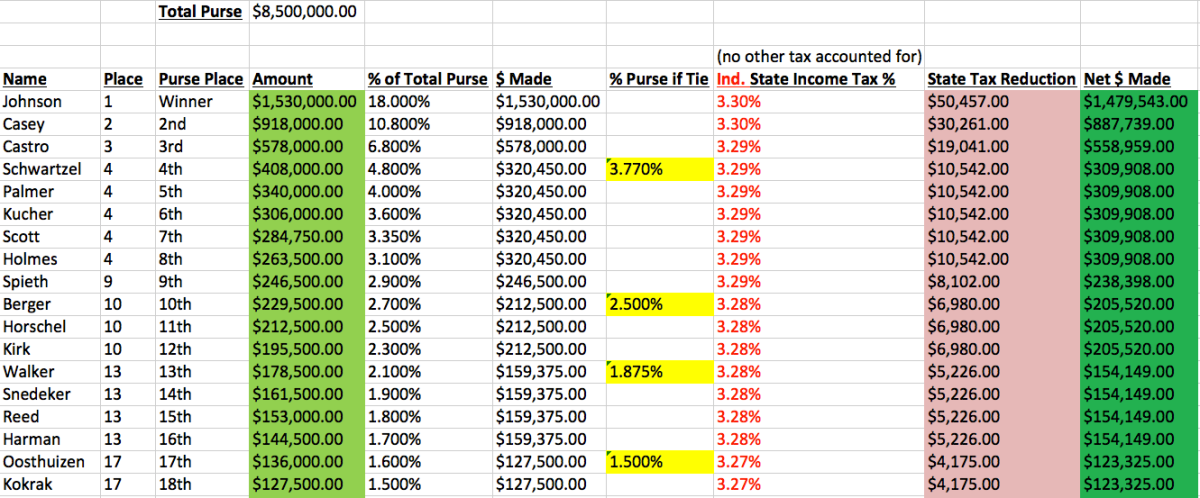
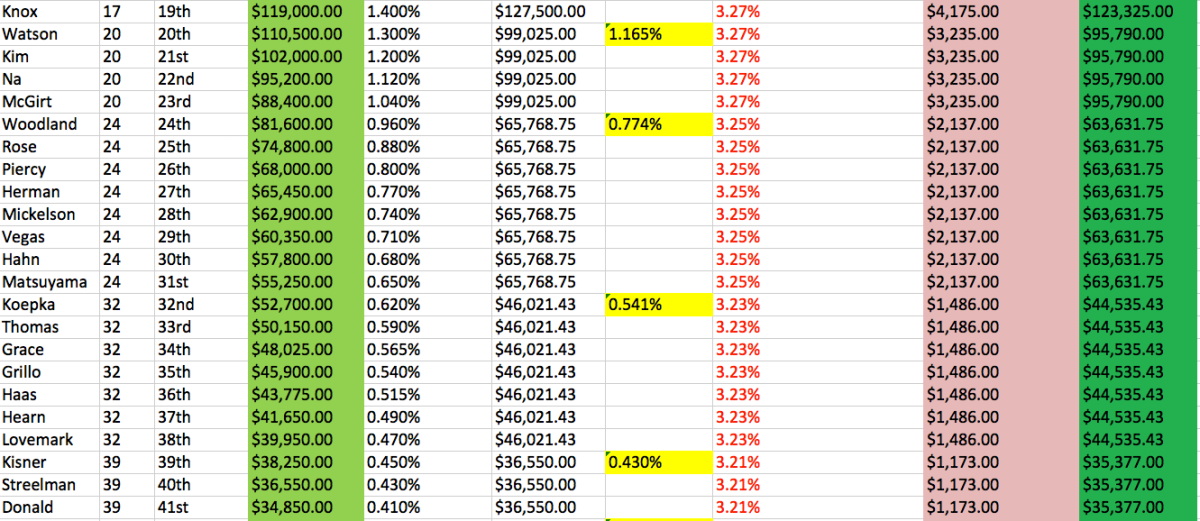


Congrats to Dustin Johnson on his great Dub at Crooked Stick.




Congrats to Rory McIlroy on his impressive Monday round and Deutsche Bank Championship.
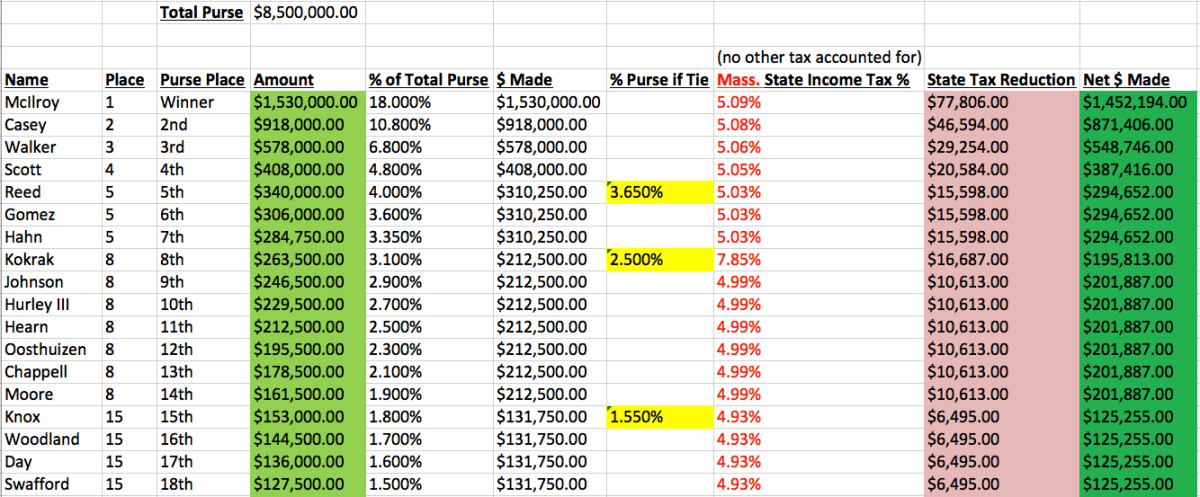
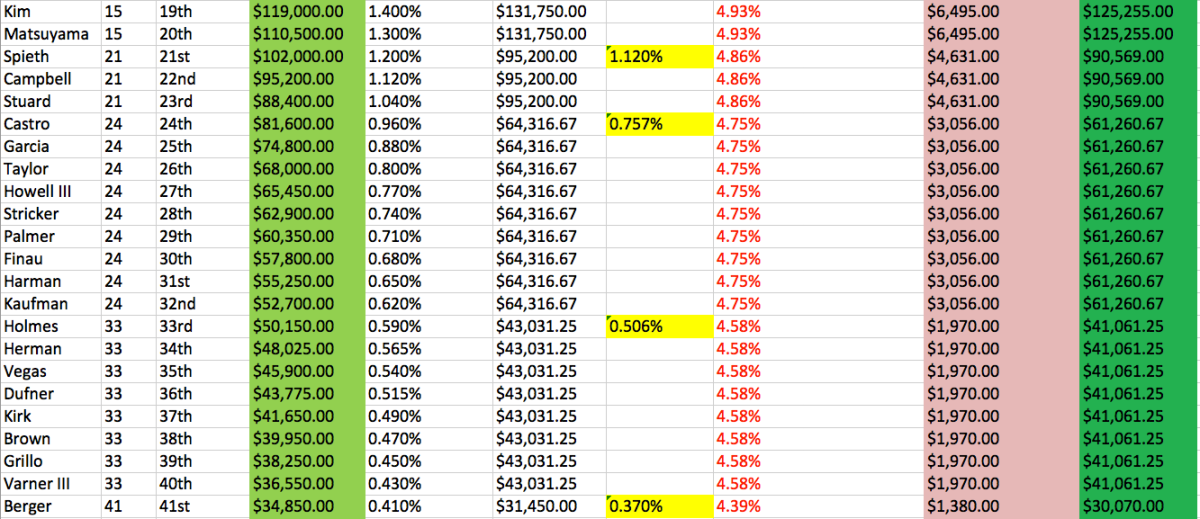
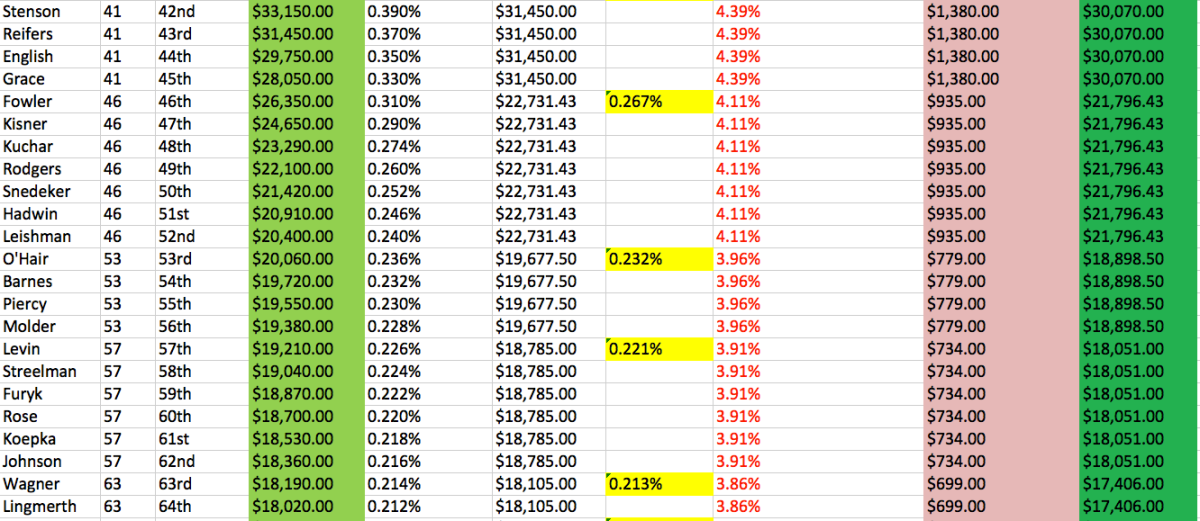

Congratulations to Patrick Reed on his victory at Bethpage Black and his 7.35% state income tax tag.
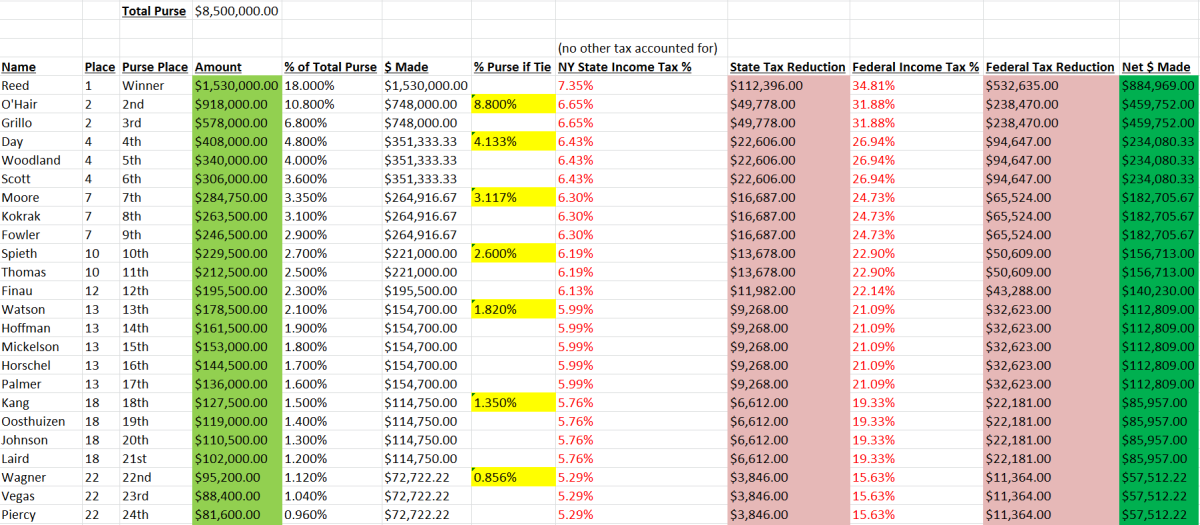
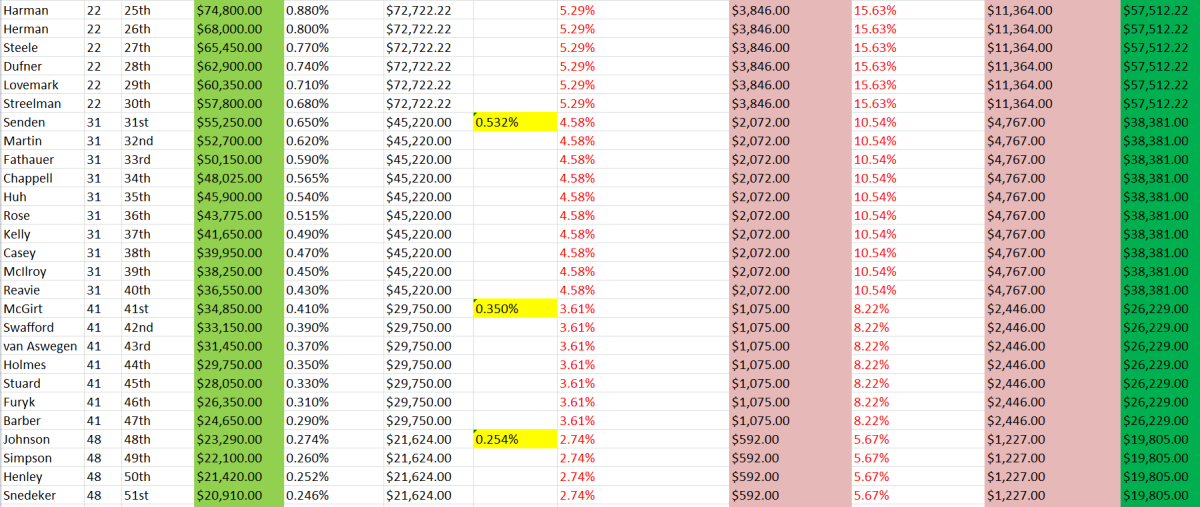
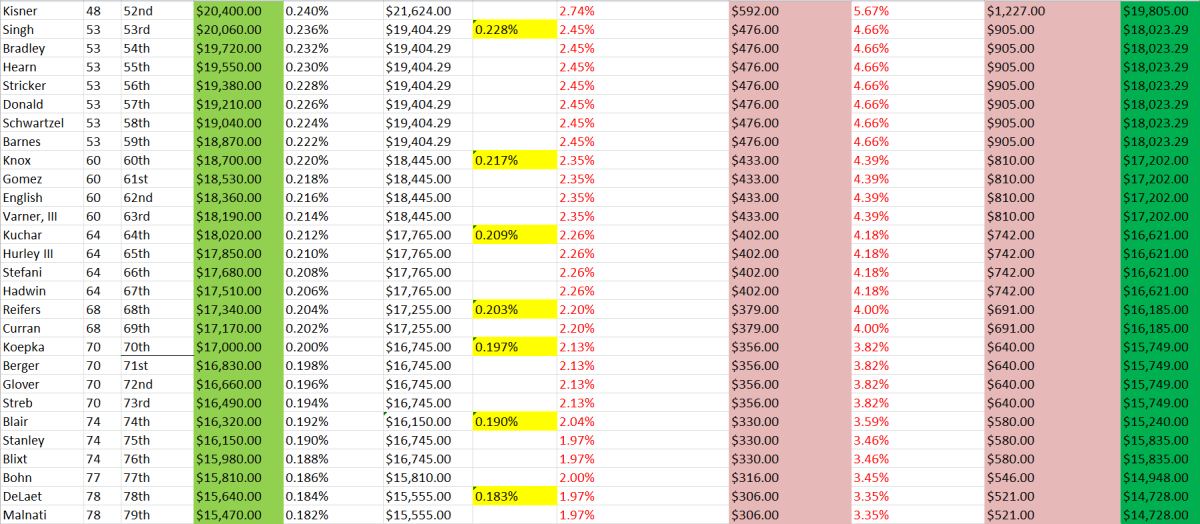
The FedEx Cup Playoffs begin today at historic Bethpage Black in Farmingdale, New York. That location and zip code have been used to calculate the state income tax associated with each finishing place for this $8.5 million purse.
I still used a standard cut to 70 players, even though I’m quite sure this cut (and all future cuts remaining for this year) and treated differently due to the arduous rules of the FedEx Cup Playoffs.
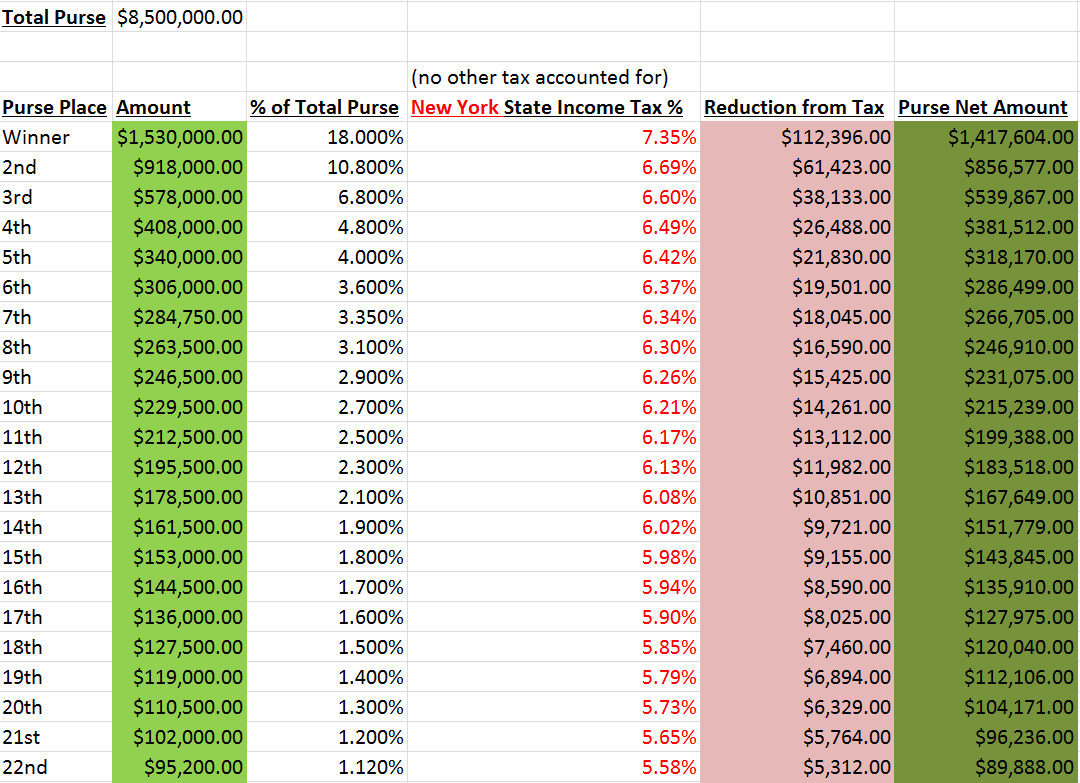
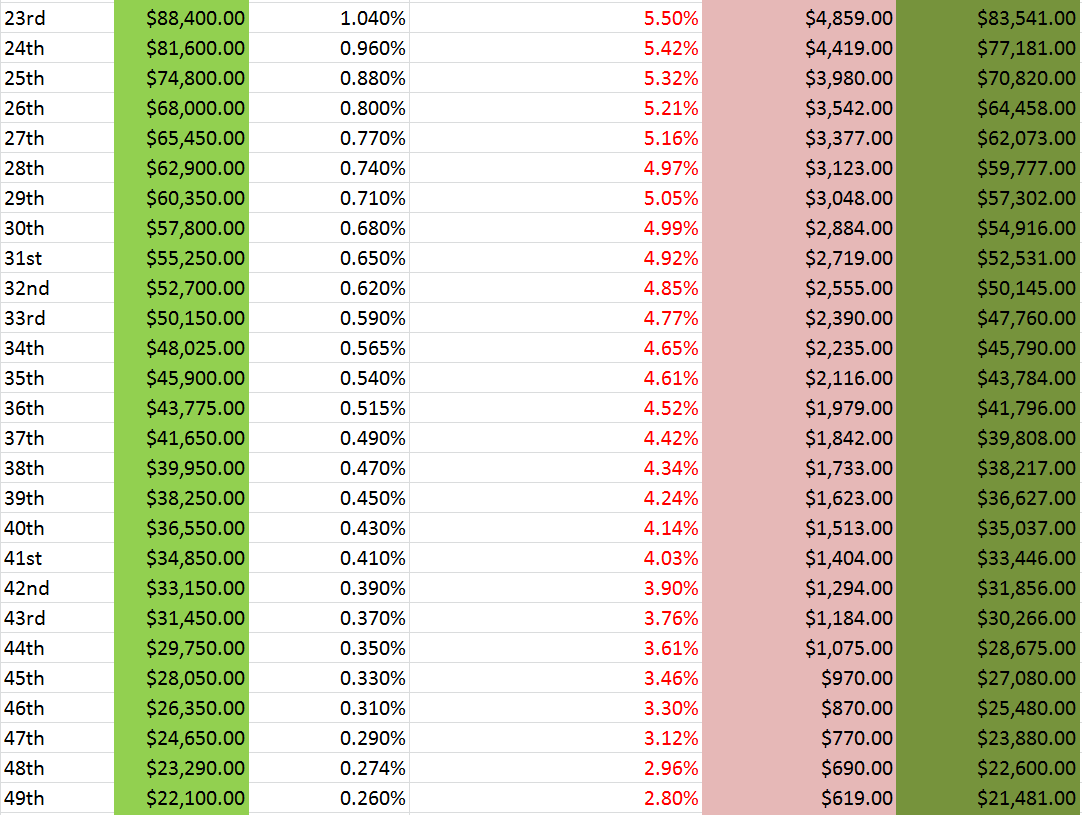
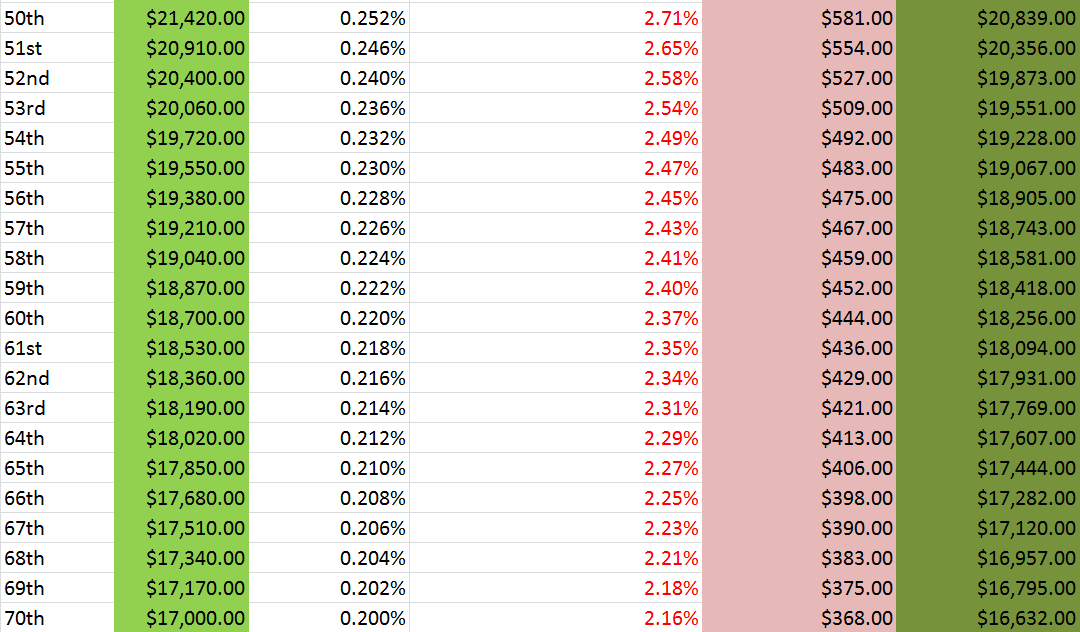
Si Woo Kim dominated this weekend in Greensboro, leading to his first place finish and a 5.71% tax hit on his prize money earnings. The breakdown from this weekend at the Wyndham Championship:
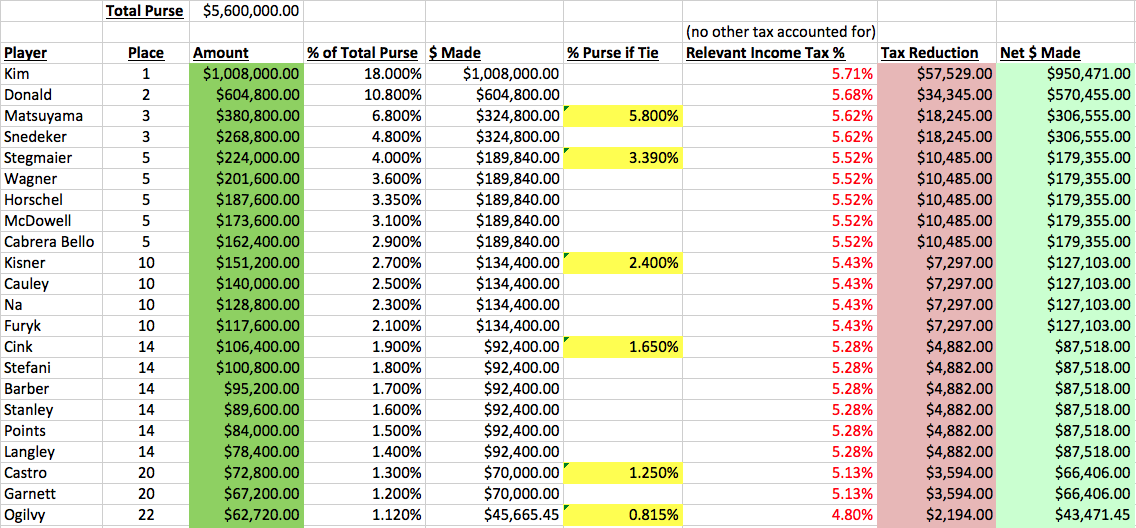
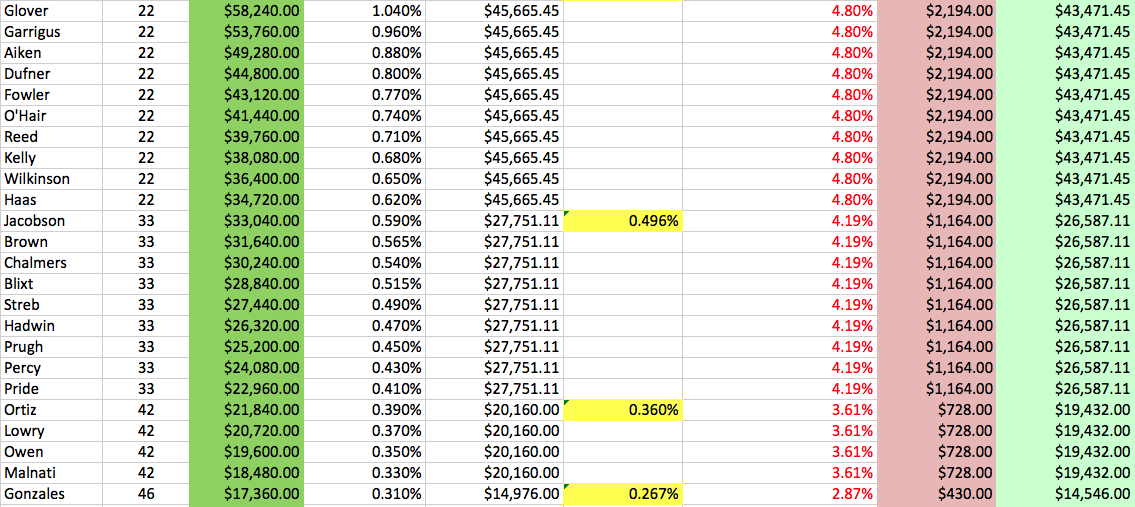
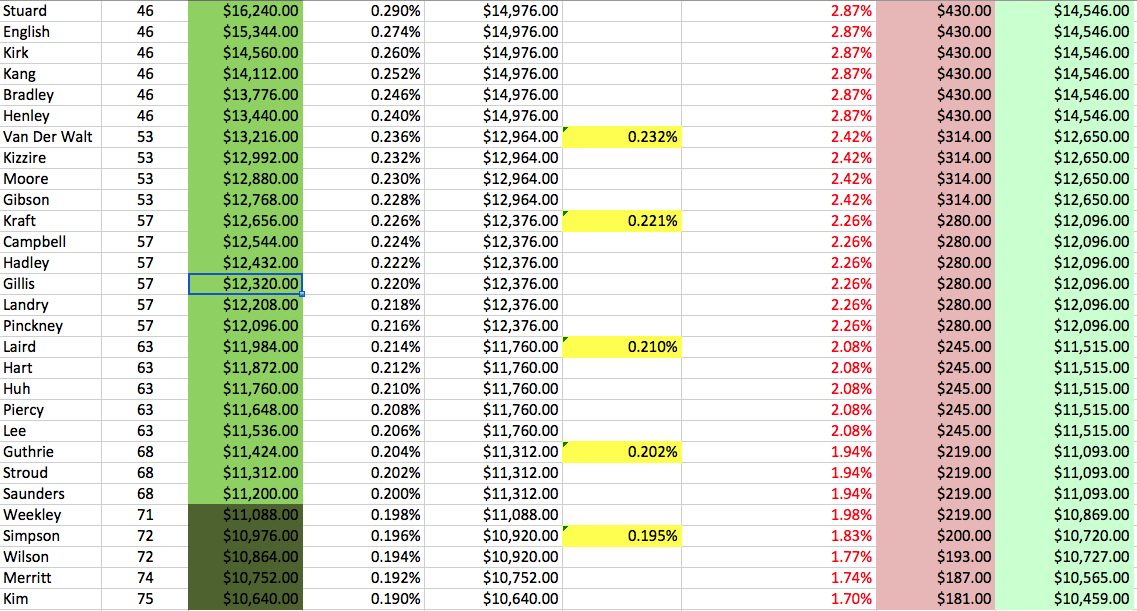
Thoughts:
Only 19 players finished tied for 14th or better this weekend, leaving plenty of cash to be distributed and split between a pretty small number of players.
Both first and second place were won outright. Third place only had 2 golfers tie, and 5th place only had five golfers tie. The field became more dense and crowded near the bottom of the cut line, as a large swath tied for 22nd and for 33rd place respectively.
33rd place sounds fairly good for a weekend PGA Tour event. This week, that position took home less than 0.5% of the entire prize money AND got their winnings taxed at a 4.19% rate.
The 9 golfers tied for that position creates a substantial dilution in prize money, allowing them to each walk away with a shade above $25,000.
The same exact thing can be said for T-42nd. Those players took him less than 0.3% of the winnings and still got hit with a 3.61% tax rate.
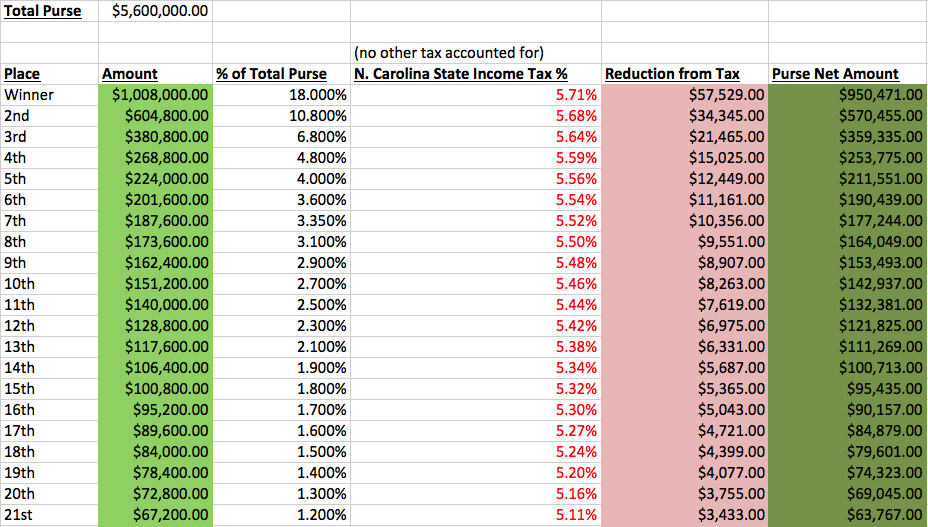
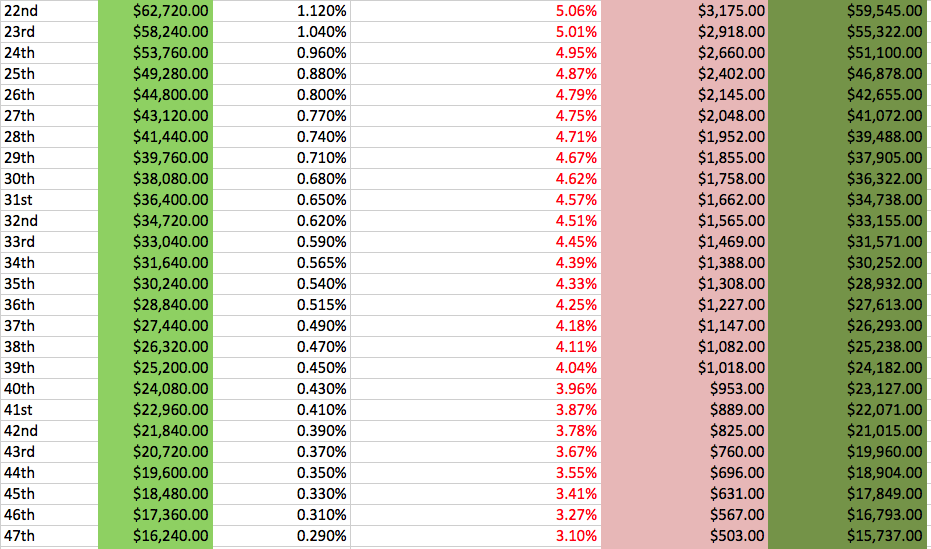
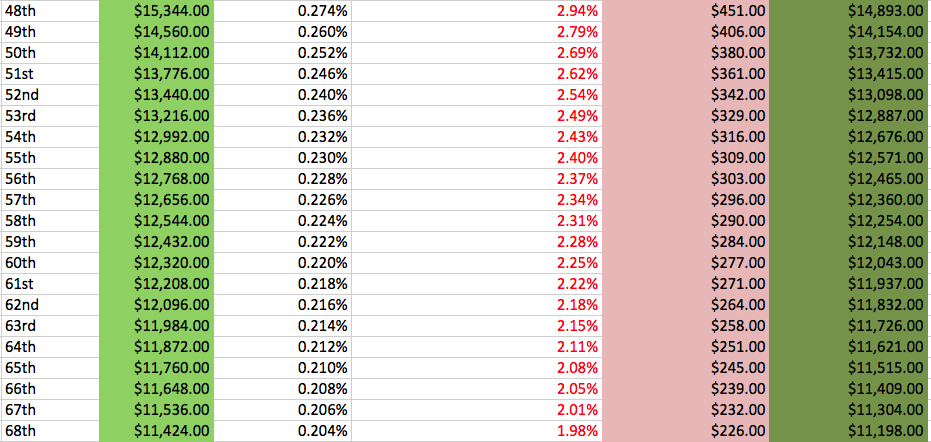

Thoughts:
I watched Back to the Future for the fist time last night. I thought it was not funny and pretty dumb. Maybe it deserves a second viewing.
These North Carolina income tax rates are not funny as well. Golfers finishing first through 23rd this weekend are going to get hit with a tax bill north of 5%.
For the sake of recency, if we were to compare the Wyndham Championship to the John Deere Classic, there are some eye-popping differences.
First, the John Deere Classic’s total purse is 15% less than the Wyndham. While $800,000 more is available this weekend, top 3 finishers this week are only netting a smidge more than the guys who did great last week in Illinois. If we eliminate the Winner’s share, mostly because the percentage he takes home relative to the entire purse is so much larger than every other golfer, we see how much these income taxes are affecting take-home pay:
With the natural tax regression occurring throughout the data, the tax rates start to plunge when a golfer’s prize money nears $25,000. We see drops of 8, 9, 9, 11, 12, and 14 percentage points respectfully for the golfers that will finish between 39th and 45th.
With more unfamiliar names than usual to compile this weekend, here’s the dollar breakdown incorporating from the great John Deere Classic in Silvis, Illinois.
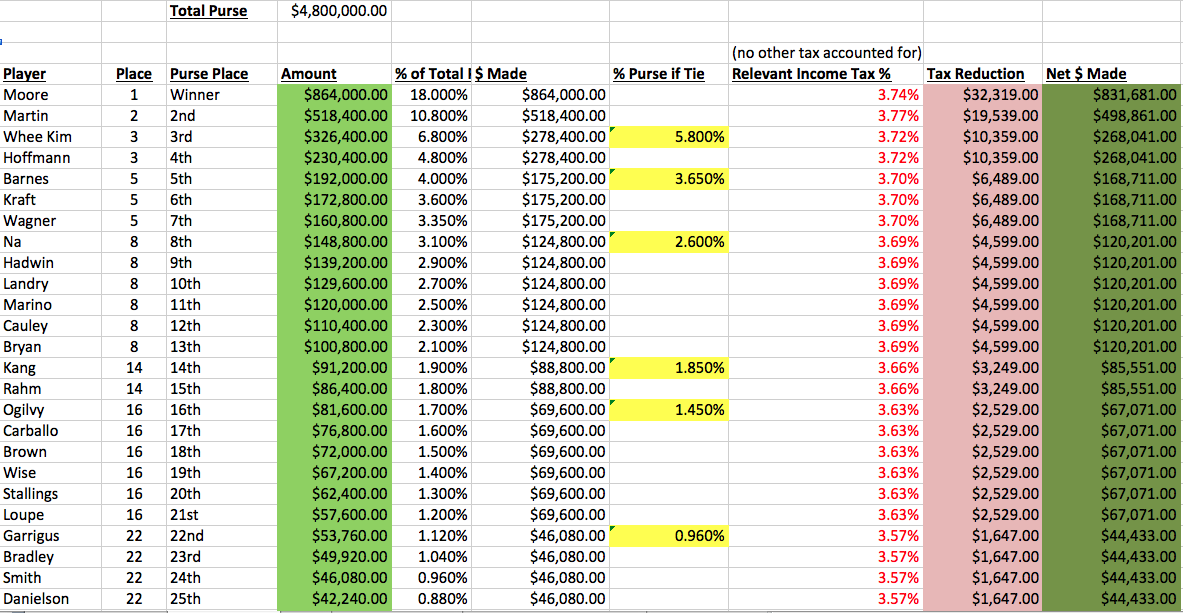
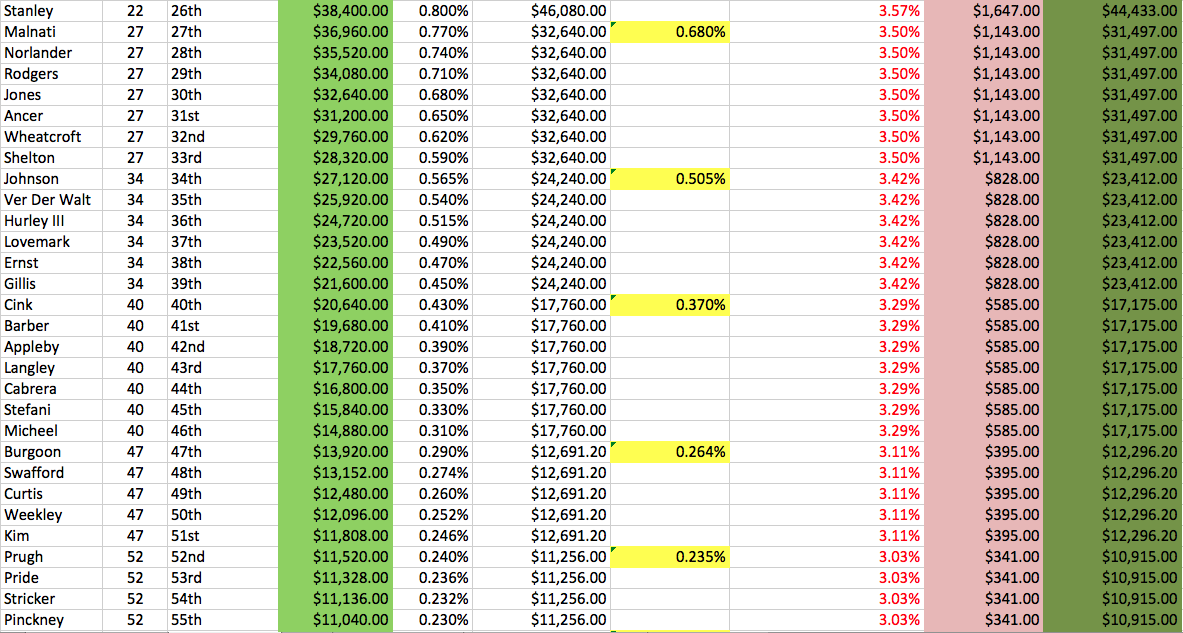

Thoughts:
I honestly have no clue. It’s the second time I’ve run these numbers using multiple sources online. The only thing I can think of is that $514,800 is near the lowest amount of dollars made in that specific tax bracket, but it should still be marginal in terms of every other bracket for all other associated dollars.
Again, I reverse engineered the actual tax rate percentage based off the annual state income tax reduction I receive when inputting the gross amount of dollars made based on the purse distribution and ties.
Pretty strange, but hopefully some rationale will surface soon.
From my records, this seems like the lowest amount of $100,000+ post-tax winners since the Canadian Open. Remember – that tournament needed du Toit finishing tied for 12th just to push some of that prize money down to those golfers that were not amateurs.
This is somewhat surprising given the small Illinois state income tax rates. However, even before golfers embarked on the Quad Cities area, the money pie was just not that big. It’s tough to divide 4,800,000 between 70 golfers, and that’s not taking into consideration guys who tie for 70th place and make the cut as well as ties that naturally depletes an individual’s prize money.
Regardless of the total dollars taken home, 40 total golfers had a state income tax hit of less than $1,000. Those tied for 34th had a fairly successful weekend in monetary terms, taking home a little more than $23,000 with a $828 state income tax bill.
From the 1st place golfer to the 61st place golfer, the tax rate on a golfer’s winnings started with the number 3, which is pretty interesting. For being quite blue politically, Illinois takes care of all with their relatively low state income tax rates, especially for those that put a bit more in their pocket.
There are a plethora of ways to dissect these Olympic golfers and the dollars they’ve made throughout their careers to provide further context.
Below is a breakdown of each player, the amount of years they’ve been a Pro, their career earnings, and determining on average how much they’ve made per year as a professional.
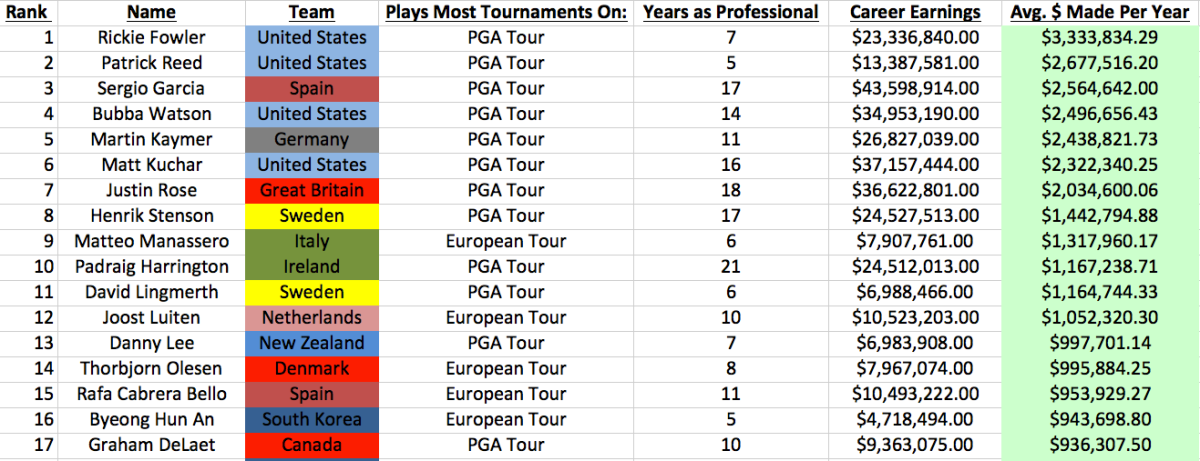
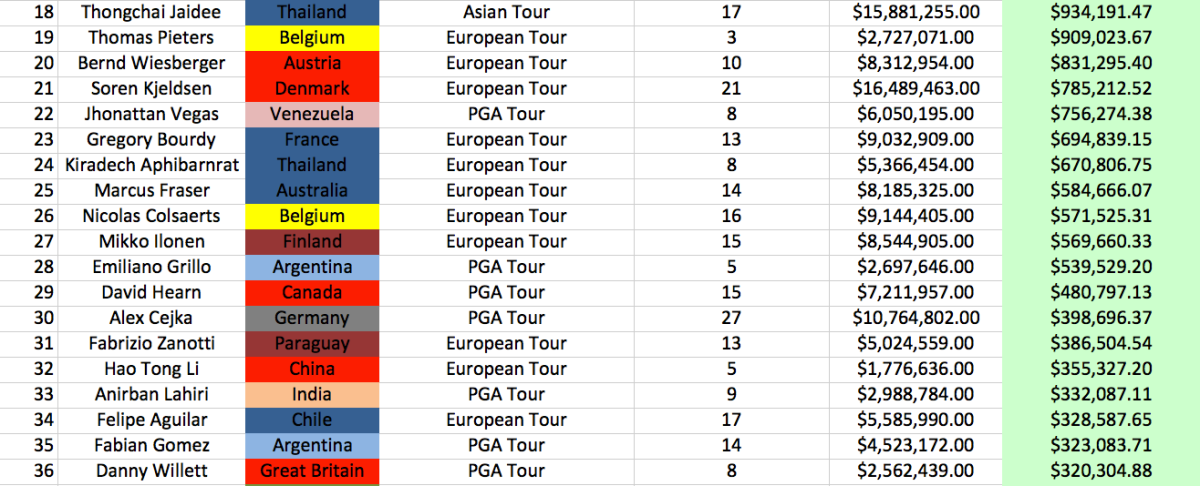
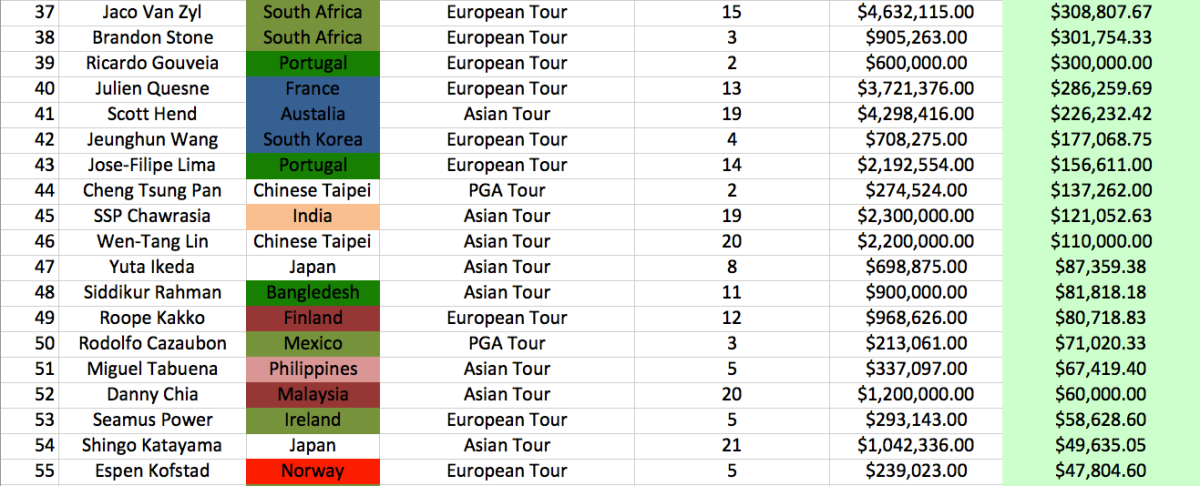

Thoughts:
I’ll provide the necessary caveat(s) later, but Rickie Fowler and Patrick Reed have had tremendous success early in their career. In turn, that provides plenty of dollar bills in their pockets. At 27 and 26 years of age respectively, these two have consistently played at a high level.
They’ve also placed very high in large purse events. Fowler won the 2015 Players Championship, bringing home $1,800,000 pre-tax. Reed won the 2014 WGC Cadillac Championship and won $1,530,000 pre-tax.
And now, onto the caveats. It’s no secret that golf has become a big business in the last 5-6 years. The total purse for the U.S. Open was $10,000,000 and $10,500,000 for the PGA Championship. There are loads of money to be made playing professional golf.
Furthermore, a majority of that large capital is housed within the PGA Tour. The PGA and/or USGA has two major revenue streams that keep growing: corporate sponsorship dollars that underwrite the large events, and television rights that have continued to skyrocket and put more capital into a golf association’s coffers.
The PGA Tour has not been shy about trying to increase its bottom line. It will not host an event at Trump Doral next year, not for political purposes but because of the dollars available from a corporate sponsor to take the event to Mexico City.
While the PGA Tour is the cream of the crop in terms of total purse amounts and its quality of players, there seems to be a trickle down effect to other tours.
The European Tour has two players participating the Olympics that have been playing for less than 10 years but are in the Top 15 in average dollars made per year.
Ranked 6th on my list, Matteo Manassero has been playing golf professionally for 6 years and bringing in a cool $1.3 million per year on average. Thorbjorn Olesen has also had major success in his 8 years predominantly on the European Tour.
I’d say that 27 years in one career is a large enough sample size to see how one can fare playing professional golf.
Like most professional athletes, the sample size of those playing golf for a living compared to the world population is microscopic.
Unlike most professional sports, professional golfers do not receive guaranteed money (outside of non-competition money like sponsorships and advertisements). They must compete every week and earn each dollar based on their performance. A baseball player can go 0-5 with 4 strikeouts, and he’ll still be paid regardless of his performance. A professional golfer shoots 9 over and misses the cut, and he heads home with $0 in earnings.
That’s why Alex Cejka’s is a great illustration that being a professional golfer kicks butt. 27 years playing and a shade under $11 million total made on Tour. That comes to about $400,000 pre-tax dollars made each year.
That’s a nice way to live.
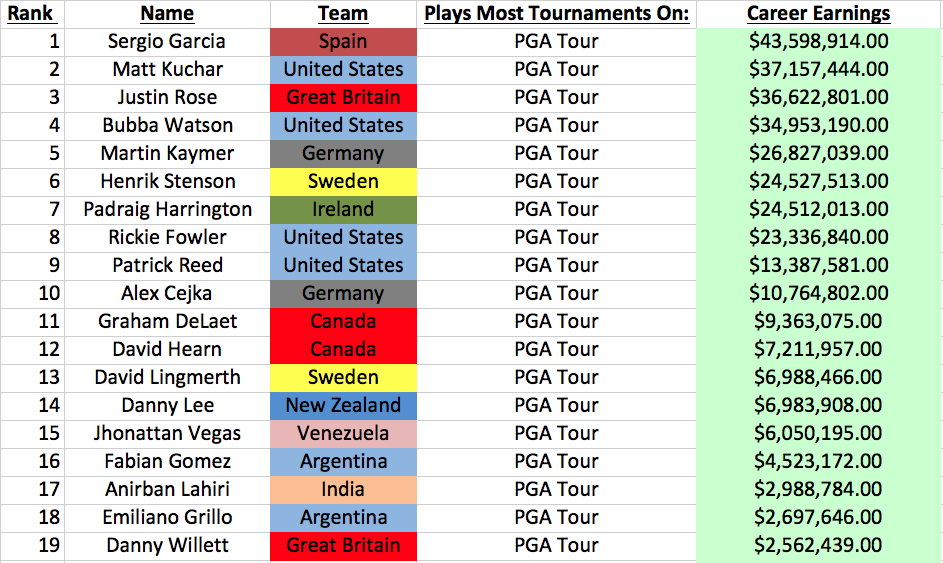
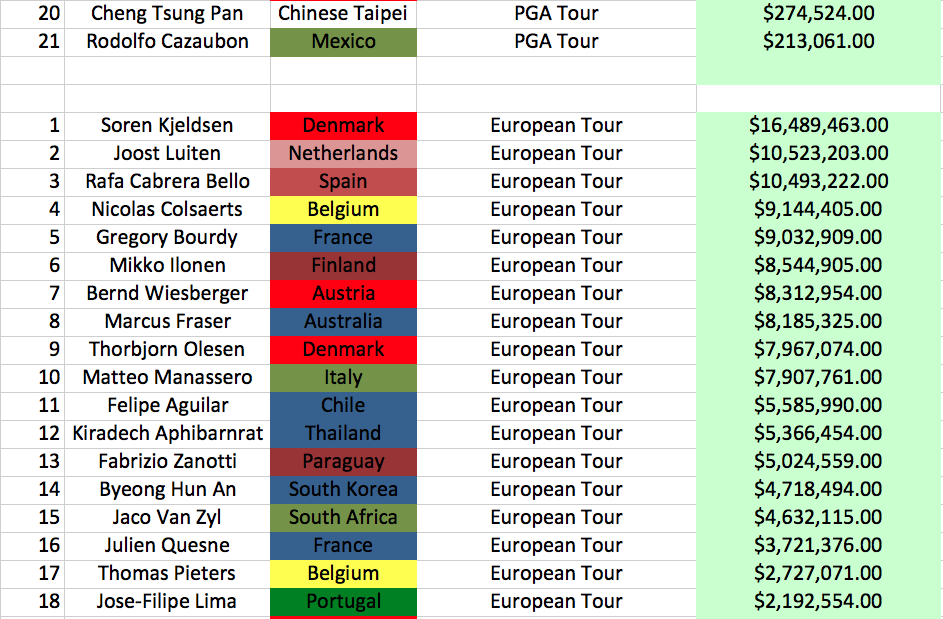
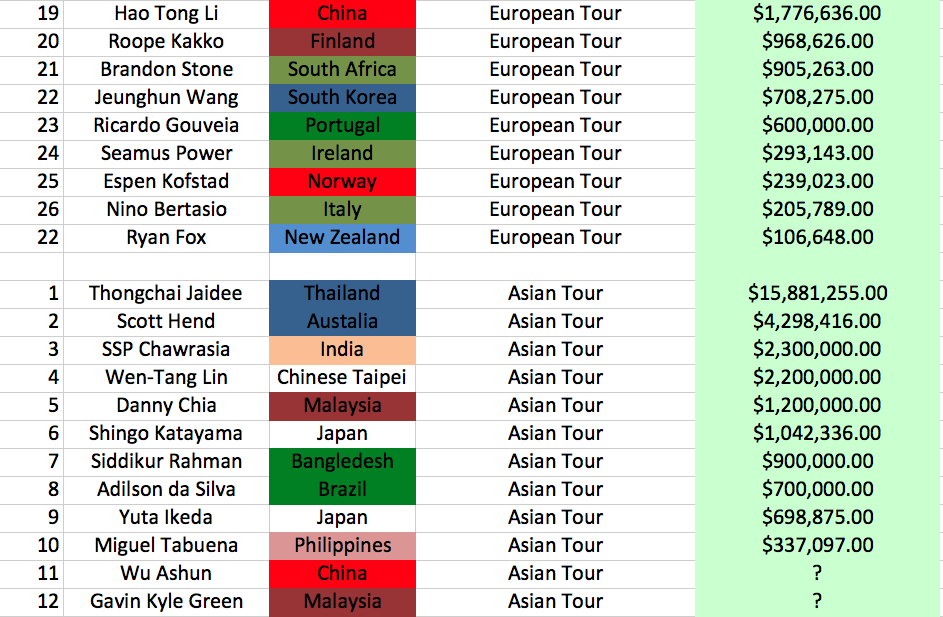
Thoughts:
As one of the most seasoned, oldest, and most experienced golfers, it’s no surprise that Sergio, the #1 ranked PGA Tour career earner in Rio, makes a ton more money than Kjeldsen and Jaidee.
But how about the miniscule gap between Jaidee, the #1 Asian Tour career earner, and Kjeldsen? Tomorrow I’ll be breaking down average amount made based on years of experience. I still find the $600,000 gap pretty surprising. Maybe it’s because of Kjeldsen’s recent kick-assery on the PGA Tour and in Majors.
Give credence to Jaidee. He’s got an $11 million buffer between himself and the second highest career earner.
Kjeldsen does have a $6 million gap from Joost Luiten, but there are other golfers that are right around that gap from him as well.
In Rio, there are 21 PGA Tour golfers and 18 European Tour golfers. The median golfer for each Tour is as follows:
PGA Tour: #11 – Graham DeLaet: $9,363,075
European Tour: #9 – Thorbjorn Olesen: $7,967,074
Maybe it’s because I live in America, but I don’t feel like the European Tour gets the admiration, respect, and coverage that it deserves. Sure, Sky Sports provides plenty of coverage, and the Golf Channel picks up some of its overseas coverage.
That’s why I’m proposing some end-of-year Tournament between the Top 8 golfers from the PGA Tour and European Tour (not during Ryder Cup years). I don’t know what purpose it would serve other than being a great PR opportunity for the European Tour and to show that the game of golf is both global and thriving around the world.
I’ll be sure to provide further insight on this throughout the weekend (i.e. dollar winnings are not created “equal” between the PGA Tour, European Tour, & Asian Tour), but here’s the breakdown of career earnings in descending order.


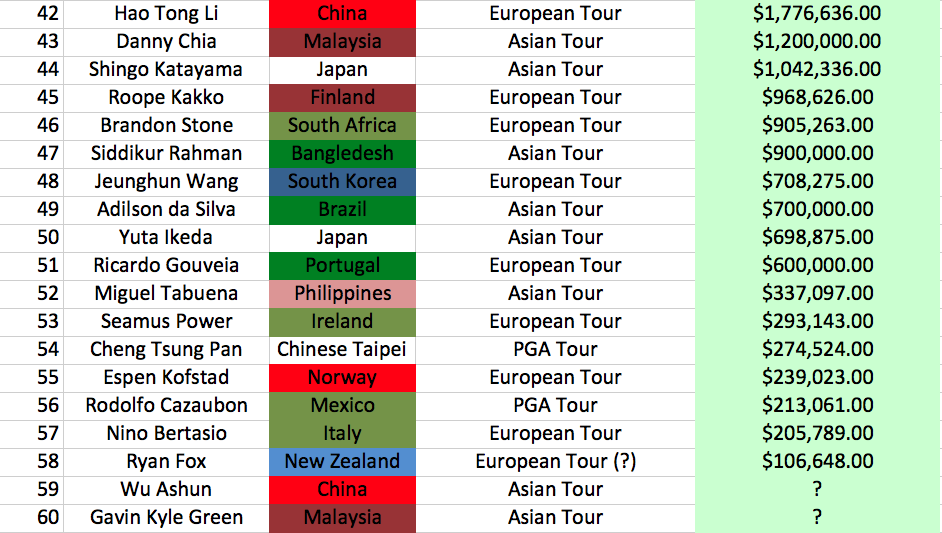
Thoughts:
Just your classic aggregation of data. Usually, I allowed Google and their powerful SEO optimization to provide a conclusion on which tour a golfer predominantly plays on.
Of course, many of these golfers cycle through all three tours – Kjeldsen has made himself well known in America from his outstanding play during majors this year, especially at Augusta.
For whatever reason, the Asian Tour website doesn’t aggregate the career earnings for a player. I did some quick mental math and got a ballpark number for those guys. So apologies to Wen-Tang Lin Fan Club if I estimated his earnings to low and he finished behind SSP Chawrasia.
From a quick glance, this is easily the biggest surprise for me. I follow the game of golf quite extensively, but that’s a name I wasn’t expecting to see so high up on the list.
Even with multiple stars electing to skip the Olympics, Luiten ranks 13th on that list and 2nd among European Tour players. He’s surpassed $10 million in career earnings.
Proficiat!
While I did say earlier that not all these dollars are “equal” – we all know the PGA Tour is much more competitive than the European or Asian Tour – dollars bills with the faces of George Washington and Abraham Lincoln are worth just the same, no matter where they are won.
44 of your 60 Olympic Golfers have surpassed the $1 million mark in career earnings.
My searching did not lead me to much information regarding either golfer, except that Ashun had a great week on the Asian Tour lately and moved up about 250 spots in the Official World Golf Rankings.
I’ll probably just tweet at the top 10-15 golf analysts out there who are in Rio and can ask Wu and Mr. Green.